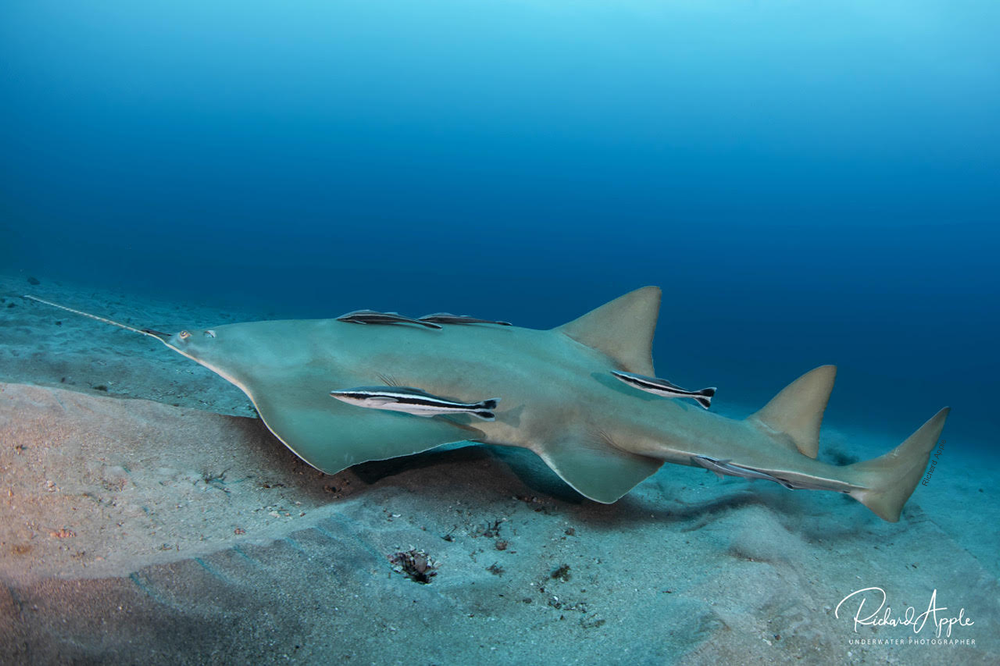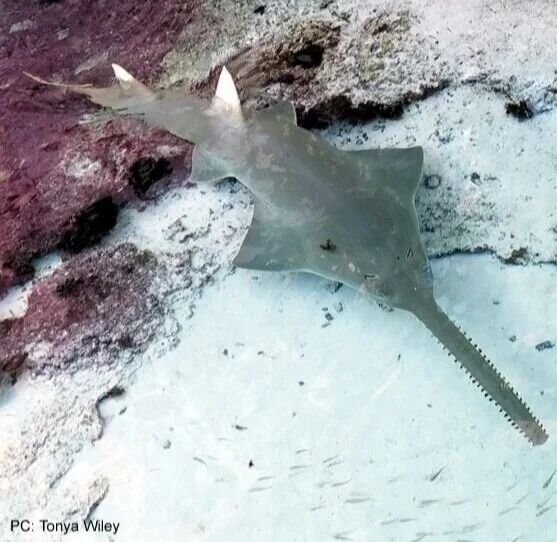
SMALLTOOTH SAWFISH Pristis pectinata
IUCN Red List: CRITICALLY ENDANGERED
The smalltooth sawfish (Pristis pectinata) sawfish was once found in coastal waters of the Atlantic Ocean from Angola to Mauritania in west Africa and from the United States to Uruguay in the Americas. Today the smalltooth sawfish appears to be most commonly found in Florida, USA, with a small and likely distinct population in the Bahamas. The smalltooth sawfish can grow to around 500 cm/16.5 ft. This species is visually most similar to the green sawfish (Pristis zijsron) and can be best identified by its relatively long and narrow rostrum (saw), small to absent lower caudal fin (tail), and large number of rostral teeth (20-30 per side). The smalltooth sawfish was the first marine elasmobranch (i.e. sharks and rays) to be listed as Endangered on the U.S. Endangered Species Act in 2003.
SIZE: 61 to 488 cm (2 to 16 ft) total length
DISTRIBUTION: Atlantic Ocean
IDENTIFICATION: Start of first dorsal (top) fin in line with start of pelvic (lower, bottom) fins, small to absent lower caudal lobe on caudal (tail) fin, and a relatively long rostrum. Rostral teeth at base of rostrum are spaced farther apart than those at tip, but not as extreme as with green sawfish.
SMALLTOOTH SAWFISH DESCRIPTION
Fin position/markings: Origin of first dorsal fin inline to that of the pelvic fin (Bigelow and Schroeder 1953). Relatively narrow and long pectoral fins (Compagno and Last 1999). Lower caudal fin lobe small to absent (Bigelow and Schroeder 1953, Compagno and Last 1999). No anal fin and no discernable markings on fins. Coloration can vary from deep brown to a light sandy-brown or sandy-grey color.
Rostral meristics and morphology: Relatively long and narrow rostrum (Compagno and Last 1999). Left and right rostral tooth counts of 20-30, and vary regionally and between sexes (Compagno and Last 1999, Wiley et al. 2008, Faria et al. 2012). Female rostral tooth counts are typically smaller than that of males (Wiley et al. 2008). Left and right rostral tooth counts do not significantly differ, and differences in these counts range from 0-3 (Wiley et al. 2008). Total rostrum length (TRL) was found to range from 21-30% of total length (TL) (Faria et al. 2012). Distal most rostral tooth gap is 19-63% that of the proximal most rostral tooth gap (Compagno and Last 1999, Faria et al. 2012). Groove on posterior margin of rostral teeth extends to base on rostral teeth in adults, but less so in juveniles (Compagno and Last 1999; Faria 2007).
Size: Pupped around 61-81 cm/2-2.7 ft TL (Poulakis et al. 2011, Bethea et al. 2012). Maximum reported length has ranged from 540 cm/17.7 ft TL (Bigelow & Schroeder 1953) to 760 cm/24.9 ft TL (Simpfendorfer 2005); however, all smalltooth sawfish captured in U.S. fishery-independent research surveys have been <500 cm TL (Brame et al. 2019) and the largest measured sawfish from these surveys was 455 cm/14.9 ft TL (Brame et al. 2019; D. Grubbs unpublished data). In 2021, a mature female was found dead in the Florida Keys and measured 488 cm/16 ft TL, making this individual the longest smalltooth sawfish measured by scientists.
Vertebral Count: Not available
SMALLTOOTH SAWFISH HABITAT
Distribution: In general, the smalltooth sawfish inhabits shallow (<10 m/33 ft) coastal waters, estuaries, and rivers of the tropics and subtropics, to a maximum depth rarely exceeding 100 m/330 ft (Carlson et al. 2014, Dulvy et al. 2016). Florida remains the region with the largest numbers of this species, primarily around the Charlotte Harbor estuary, Caloosahatchee River, Ten Thousand Islands, and Everglades National Park on the west coast of Florida (Brame et al. 2019). However, there are an increasing number of encounter reports of larger sawfish on the east coast of Florida and a few reports of juveniles (Wiley and Simpfendorfer 2010, G. Poulakis unpublished data). Encounter data also shows scattered reports of sawfish in northern Florida, Georgia, Mississippi, and South Carolina. However, acoustic telemetry suggests these sawfish are migrants that travel up the coast during warmer times of the year before returning south as waters cool (Graham et al. 2021).
Habitat: The smalltooth sawfish displays ontogenetic habitat partitioning (i.e., different age/size classes occupy different habitats/depths) (Simpfendorfer et al. 2010, Wiley and Simpfendorfer 2010). Juveniles inhabit shallow rivers, creeks, canals, and estuaries (Simpfendorfer et al. 2010, Norton et al. 2012, Poulakis et al. 2012). With an increase in size, individuals slowly transition to deeper and more saline waters (Simpfendorfer et al. 2010).
In Florida, USA, young smalltooth sawfish habitat often consists of shallow waters in close proximity to red mangroves (Rhizophora mangle) (Norton et al. 2012, Hollensead et al. 2018) and typically consists of salinity between 18 and 30 psu (Poulakis et al. 2011, Simpfendorfer et al. 2011). Young individuals have increased rates of movement and move away from shorelines at night (Poulakis et al. 2016, Huston et al, 2017, Hollensead et al. 2018, May et al. 2019). Small juvenile sawfish have been observed to move further upstream in riverine environments during times of increased salinity in the Caloosahatchee River (Simpfendorfer et al. 2011, Poulakis et al. 2012). Young juveniles have also been shown to have high site fidelity to particular areas (Poulakis et al 2011, 2013, 2016, Hollensead et al. 2016, 2018). Juveniles typically inhabit nursery areas for 2-3 years (Simpfendorfer et al. 2010, Scharer et al 2012). Recent acoustic tag data indicate that juveniles around 150-220 cm/5-7 ft TL migrate over greater distances than previously documented (A. Kroetz, unpublished data).
Acoustic and satellite tag data show larger juvenile and adults traveling long distances and migrating along either coast of Florida (Graham et al. 2021). Adults typically occupy waters farther from shore than juveniles (Wiley and Simpfendorfer 2010). Adults have been observed to move into depths of over 100 m/330 ft (Seitz and Poulakis 2002, Poulakis and Seitz 2004, Simpfendorfer 2005), but mostly inhabit depths <10 m (Carlson et al. 2014). Recent research from archival satellite tags indicates that large male sawfish spent approximately 35% of time at 30 m/100 ft depth while females spend 20% of their time at 100 m/330 ft.
SMALLTOOTH SAWFISH LIFE HISTORY
Age and growth: This species grows rapidly in the first two years of life and matures earlier than previously thought (Simpfendorfer et al. 2008, Scharer et al. 2012, Carlson & Simpfendorfer 2015). Juveniles double in length in the first year of life and can exceed 200 cm/6.6 ft TL in their second year (Scharer et al. 2012, Brame et al. 2019). Simpfendorfer et al. (2008) estimated a k-value of 0.140 per year (Linfin = 600 cm/19.7 ft, t0 = -0.863 years) for the smalltooth sawfish, using length frequency analysis and recapture data from 144 individuals ranging in total length from 69-496 cm/2.3-16.3 ft. Conversely, Scharer et al. (2012) observed a much larger k-value of 0.219 per year (Linfin = 448 cm/14.7 ft, t0 = -0.81 years), using vertebral analysis of 15 individuals ranging in total length from 60-435 cm/2-14.3 ft. Simpfendorfer et al. (2008) determined the smalltooth sawfish to nearly double in size within their first year, as also observed in field recapture data (A. Kroetz & R. Scharer, unpublished data). Maximum age is estimated to be approximately 30 years (Carlson & Simpfendorfer 2015) based on available age and growth data. The oldest known captive smalltooth sawfish died at 43 years old, and the oldest current smalltooth sawfish in captivity has been held since November 1989 (Brame et al. 2019, White and Henningsen 2017).
Reproduction: Reproduction is sexual with internal fertilization. This species is yolk-sac viviparous and live young are born in estuarine waters (NMFS 2000) around 64 to 81 cm/2.1 to 2.7 ft (Poulakis et al 2011, A. Kroetz & J. Carlson, unpublished data, D. Grubbs unpublished data). However, facultative parthenogenesis (asexual birth occurring without a male contribution) occurred in seven wild juvenile sawfish. Rudimentary hermaphroditism is evident in all necropsied male sawfish having ovotestes (J. Gelsleichter & G. Poulakis unpublished data, Brame et al. 2019). Young are born with fully developed rostral teeth that are covered by a hardened gelatinous sheath. Recent information reports litter size to be 7-14 pups (Feldheim et al. 2017, Smith et al. 2021). Gestation period is approximately 1 year, and individual females have a biennial reproductive cycle (Feldheim et al. 2017). In Charlotte Harbor, Florida, pupping appears to occur between November-July and peaks in April-May (Poulakis et al. 2011). Further south in Everglades National Park, pupping occurs in all months except September, peaking between March and July (Brame et al. 2019; J. Carlson unpublished data). Within the Charlotte Harbor and Everglades National Park estuarine systems, females return to the same nursery to give birth with many of these females returning to give birth for over a decade (Feldheim et al. 2017, Smith et al. 2021).
Maturity: Size of maturity is approximately 340 cm/11.2 ft TL for males and 370 cm/12.1 ft TL for females (Brame et al. 2019; J. Gelsleichter unpublished data). Age at maturity is estimated to be between 7-11 years (Carlson & Simpfendorfer 2015).
SMALLTOOTH SAWFISH DIET
Using stable isotope ratios of carbon (δ13C) and nitrogen (δ15N) obtained from fin clips, this species has been found to feed primarily on teleost (most ray-finned fishes) and elasmobranchs (sharks and rays) fishes at all life stages (Poulakis et al. 2017). Analysis of fecal samples from 16 juvenile sawfish (< 250 cm/8.2 ft) using a high taxonomic molecular technique showed they were feeding on a number of fish species with the most common being tidewater mojarra, silver perch, spotted seatrout, bay anchovies, and pinfish (Hancock et al. 2019). Direct observations also indicate that sawfish of all sizes prey upon schooling fishes such as clupeids (herring, shads), carangids (jacks), muglids (mullets), elopids (ladyfish), sparids (breams, porgys), belonids (needlefish), and some elasmobranchs like dasyatids (stingrays) (Poulakis et al. 2013, 2017; J. Carlson & D. Grubbs unpublished data).
CONSERVATION
The smalltooth sawfish is listed as Endangered under the U.S. Endangered Species Act and Critically Endangered on the IUCN Red List. This species is also listed on Appendix I of CITES, prohibiting international commercial trade. These designations under national and international programs provide protections for smalltooth sawfish, although threats remain. Primary threats to the U.S. population of smalltooth sawfish include bycatch in fisheries, habitat loss, including loss as a result of climate change, and natural mortality events (Brame et al. 2019).
Listing under the ESA afforded the species initial protections but also triggered additional conservation considerations. Critical habitat for juvenile smalltooth sawfish was designated in 2009 to protect nursery habitats in southwest Florida (Norton et al. 2012) and a recovery plan was developed to lay out a roadmap for rebuilding the population (NMFS 2009). The recovery plan prioritizes actions aimed at educating the public, reducing threats, monitoring the population, and conserving habitat. Over the past decade this document has guided researchers, managers, and other conservation partners in successfully conserving smalltooth sawfish. A study on relative abundance from scientific surveys indicates that the U.S. distinct population is stabilizing (Carlson et al., unpublished). Despite the success to date, Simpfendorfer (2000) suggested that recovery of this species, to a level where extinction is of little risk, would take at least several decades.
Public encounters (sightings or captures) of smalltooth sawfish are one method for monitoring the population of smalltooth sawfish through time. Encounters are encouraged to be reported to the Smalltooth Sawfish Recovery Implementation Team (SSRIT) by way of electronic reporting at www.sawfishrecovery.org or by calling 1-844-4SAWFISH. As this species begins to recover, it may be more common for encounters and interactions to occur. If a smalltooth sawfish is accidentally captured in fishing gear, please follow safe handling and release guidelines on the SSRIT website.
COMPOSED BY ANDREA KROETZ and RACHEL SCHARER




